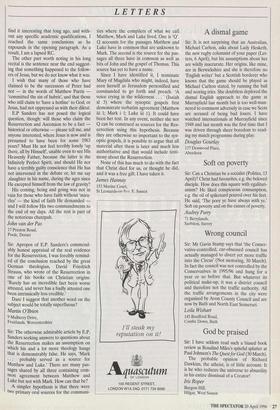Sir: The otherwise admirable article by E.P. Sanders seeking answers
to questions about the Resurrection makes an assumption on which his and a lot more theology hangs that is demonstrably false. He says, 'Mark • • probably served as a source for Matthew and Luke.' There are many pas- sages shared by all three containing com- mon agreement between Matthew and Luke but not with Mark. How can that be?
A simpler hypothesis is that there were two primary oral sources for the communi- ties where the compilers of what we call Matthew, Mark and Luke lived. One is 'CY. Q accounts for the passages Matthew and Luke have in common that are unknown to Mark. The second is the source for the pas- sages all three have in common as well as bits of John and the gospel of Thomas. This source has yet to have a name.
Since I have identified it, I nominate Mary of Magdala who might, indeed, have seen herself as Jerusalem personified and commanded to go forth and preach. 'A voice crying in the wilderness . . . ' (Isaiah xl 3) where the synoptic gospels first demonstrate verbatim agreement (Matthew iii 1; Mark i 1; Luke iii 1). It could have been her text. In any event, neither she nor Q can be construed as sources for the Res- urrection using this hypothesis. Because they are otherwise so important to the syn- optic gospels, it is possible to argue that all material after them is later and much less authoritative and that would include testi- mony about the Resurrection.
None of this has much to do with the fact that Christ died for us, or thought he did, and it was a free gift. I have taken it.
James Hannay
153 Marine Court, St Leonards-on-Sea. E. Sussex


































































 Previous page
Previous page